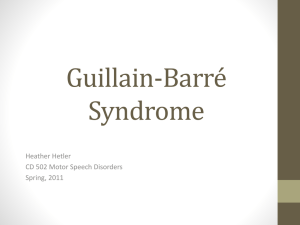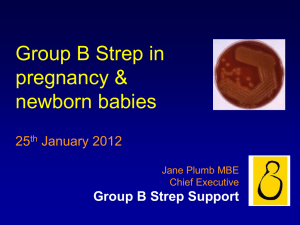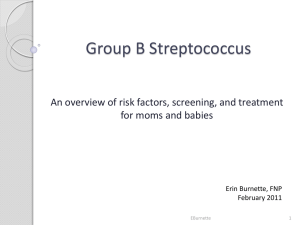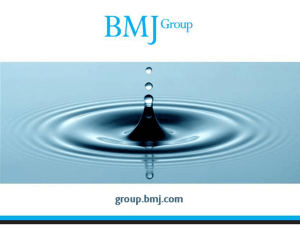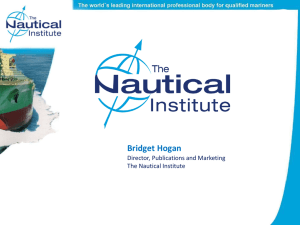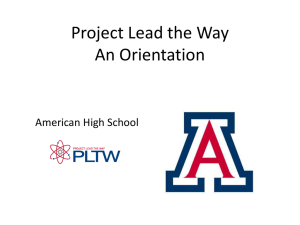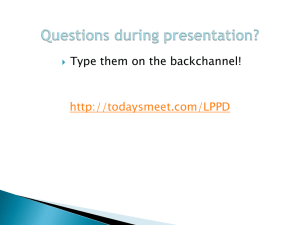IMO Goal-Based Ship Construction Standards Presentation
advertisement
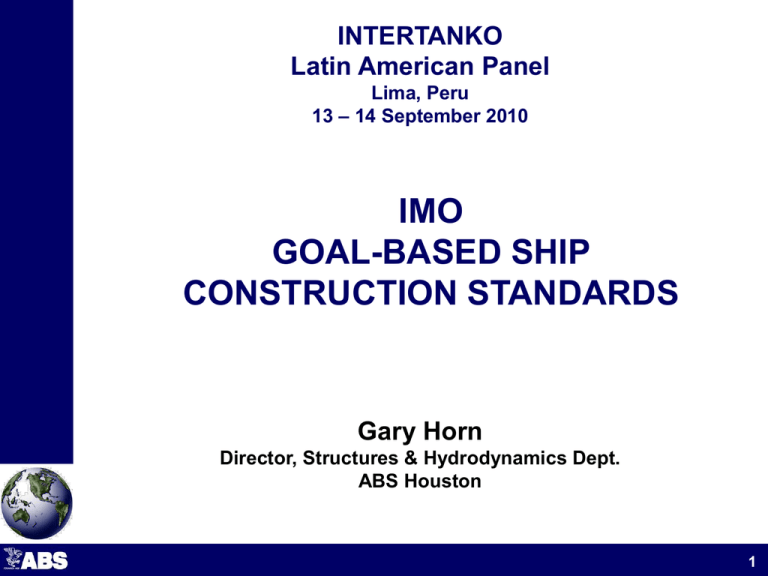
INTERTANKO Latin American Panel Lima, Peru 13 – 14 September 2010 IMO GOAL-BASED SHIP CONSTRUCTION STANDARDS Gary Horn Director, Structures & Hydrodynamics Dept. ABS Houston 1 Presentation Outline History Goal-Based Standards (GBS) The prescriptive approach The safety level approach Harmonized Common Structural Rules (CSR) 2 GBS History IMO Member States decided to establish GBS for ship design and construction First presented in 2002 at MSC 76 Adopted in 2010 at MSC 87 Will apply to oil tankers and bulk carriers starting in 2016 (Note, Class Rules will incorporate GBS starting in early 2014) 3 Goal-Based Standards ● IMO GBS is a high-level list of goals which are stated in order to provide overall guidance for the development of Rules and Standards. ● The IMO GBS contains multi-layers (tiers) that provide greater detail information as one goes from one level to the next. ● The GBS is intended for developers of Rules or Standards and is not a Rule or Standard itself, GBS is a set of “Rules for Rules”. ● Designers will then apply the classification Rules and Standards. 4 Goal-Based Standards “Rules for the rules” ● If Class Rules and Industry Regulations satisfy GBS, and vessels are constructed to Class Rules and Industry Regulations; than vessels satisfy GBS ● Class Rules have to be verified as complying with GBS (i.e. Tier III verification) Generic GBS Guidelines ● IMO drafting a generic guideline for developing GoalBased Standards 5 Goal-Based Standards Prescriptive Format: Applicable to Oil Tankers 150m in length and above and Bulk Carriers 90m in length and above Tier I (Goals) Tier II(Functional Requirements) Tier III (Documentation and Verification Criteira Guidelines) Ship Construction File SLA Format Terms of Reference Collect info on current safety levels Definitions of categories Develop long-term work plan 6 GBS Prescriptive Format IMO Documents Amendments to SOLAS Chapter II-1 making the GBS standards for bulk carriers and oil tankers mandatory [Adopted IMO Res. MSC 290 (87)] International Goal-Based Ship Construction Standards for Bulk Carriers and Oil Tankers [Adopted IMO Res. MSC 287 (87)] Guidelines for Verification of Conformity with Goal-Based Ship Construction Standards for Bulk Carriers and Oil Tankers [Adopted IMO Res. MSC 296(87)] Guidelines for the Information to be included in a Ship Construction File (SCF) [Approved MSC.1/Circ.1343] 7 GBS Prescriptive Format Tier I Tier II Goals IMO Functional Requirements Tier III Verification and Acceptance criteria Tier IV Requirements, Rules and Industry Standards Tier V Procedures and Quality Systems IMO IMO IACS Industry 8 GBS Prescriptive Format Basic Principles IMO goal-based standards are: broad, over-arching safety, environmental and/or security standards that ships are required to meet during their lifecycle the required level to be achieved by the requirements applied by class societies and other recognized organizations, Administrations and IMO clear, demonstrable, verifiable, long standing, implementable and achievable, irrespective of ship design and technology specific enough in order not to be open to differing interpretations 9 GBS Prescriptive Format Tier I – Goals Ships are to be designed and constructed for a specified design life to be safe and environmentally friendly, when properly operated and maintained under the specified operating and environmental conditions, in intact and specified damage conditions, throughout their life. Goals Functional Requirements Verification & Acceptance criteria Requirements, Rules & Industry Standards Procedures and Quality Systems 10 GBS Prescriptive Format Tier II – Functional Requirements 25 year design life North Atlantic environment Suitable safety margins at net scantlings 25 year fatigue life in North Atlantic Sufficient residual strength Protection against corrosion Coating design life specified Goals Functional Requirements Verification & Acceptance criteria Requirements, Rules & Industry Standards Procedures and Quality Systems 11 GBS Prescriptive Format Tier II – Functional Requirements Adequate corrosion margins Structural redundancy Watertight and weathertight integrity Design transparency Construction quality procedures Construction survey Survey and maintenance Structural accessibility Recycling Goals Functional Requirements Verification & Acceptance criteria Requirements, Rules & Industry Standards Procedures and Quality Systems 12 GBS Prescriptive Format Tier III – Verification Part A – Verification Process Part B – Information / Documentation and Evaluation Criteria Goals Functional Requirements Verification & Acceptance criteria Requirements, Rules & Industry Standards Procedures and Quality Systems 13 Safety Level Approach (SLA) Basic Principles Will quantify the acceptable level of safety for an envisaged rule or regulation by e.g. comparison of an attained safety level with a required safety level A minimum safety level that all ships, regardless of age, will have to comply with The minimum safety level should be defined by IMO Will enable an assessment of the envisaged rule or regulation to be developed in an efficient and reliable manner defined to overcome any observed deficiencies. 15 Safety Level Approach (SLA) Work Plan Determination of current safety levels in a holistic high level manner for individual ship types (for Tier I goals) Consideration of previous FSA studies for use in the development of the SLA (for risk acceptance criteria) Consideration of an appropriate tier structure for use in the SLA approach 16 CSR Harmonization Project CSR (Common Structural Rules) developed separately for Tankers and Bulk Carriers IACS agreed to harmonize the rules, which is currently in progress. Key elements such as wave loads, fatigue, finite element analysis and buckling. Harmonized CSR will consist of three parts − a common part and two separate parts for ship type specific requirements. 17 CSR Harmonization Project Project Teams: Loads Buckling FEM Corrosion Welding Fatigue of Hatch Cover Ships in Operation Fatigue Prescriptive Requirements Consequence Assessment 18 CSR Harmonization Project Schedule: The schedule for the harmonization project is now tied to submission of the Rules to IMO GBS verification. Schedule covers both the development phase and the Industry Hearing (implementation) phase. New schedule calls for an accelerated development phase and a longer external hearing phase. 19 CSR Harmonization Project Schedule: Item Start End date External review - Round 1 (include industry presentations) 1 Nov 2012 31 Jan 2013 Rule re-work 1 Feb 2013 28 Feb 2013 External review - Round 2 (include industry presentations) 1 Mar 2013 31 Mar 2013 Rule re-work 1 Apr 2013 30 Apr 2013 Class TC review 15 May 2013 15 Jun 2013 IACS Adoption 30 Jun 2013 30 Jun 2013 Submit to IMO GBS 31 Dec 2013 31 Dec 2013 20 Q&A History Goal-Based Standards (GBS) The prescriptive approach The safety level approach Harmonized Common Structural Rules (CSR) 21 www.eagle.org 22

